Updated: November 10th, 2022
This article contains affiliate links. Read the full disclosure here.

© JLSnader / Adobe Stock
In a previous article, I detailed the many benefits using a dog crate can provide for both you and your dog.
I then dispelled the myth of using a dog crate being cruel… as long as you use it correctly!
I then followed up with advice on both when you should as well as when you should not use a crate, to be sure you only ever use it with your dog’s best interests in mind and never in a selfish or cruel way.
The next step toward crate training your Golden Retriever is to buy a suitable crate before training them how to use it. This article aims to answer the question: ‘What is the best crate for a Golden Retriever?’ before I continue with a guide to crate training in my next article of the series.
-
-
The Classic Wire Dog Crate – Best Overall
-
Wooden / Stylish Dog Crates – Runner Up
-
Plastic Dog Crates – Best Budget
-
Fabric / Soft-Sided Dog Crates – MOST POPULAR
-
MidWest iCrate Double Door Crate –PREMIUM CHOICE
-
An Overview of the Best Size Dog Crates
| IMAGE | PRODUCT | |
|---|---|---|
 | BEST OVERALL
| VIEW LATEST PRICE → |
 | Runner Up
| VIEW LATEST PRICE → |
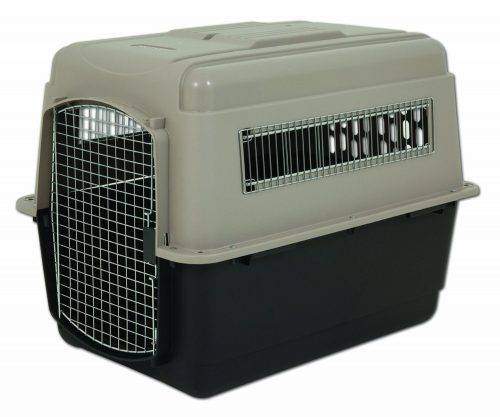 | Best for Budget
| VIEW LATEST PRICE → |
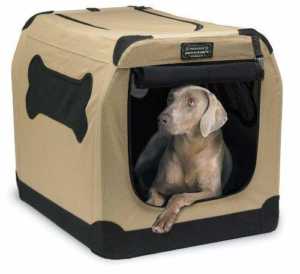 | Most Popular
| VIEW LATEST PRICE → |
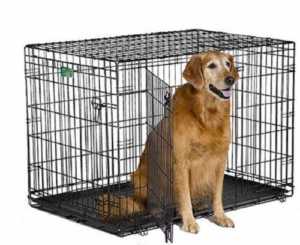 | Premium Choice
| VIEW LATEST PRICE → |
Finding the Right Crate Size for Your Dog Isn’t Always Easy
There are so many different dog crates to choose from that the decision on which to buy can be quite difficult.
First of all, the most important decision you’ll have to make is the size. Too large or too small and it will not be fit for purpose. You have to get this just right.
But then there are the different styles, the different materials they’re made from, and how and where the crate will fit into your home that will play a part in your final decision of which to buy.
This article will discuss all these factors so that by the end you will be highly informed and confident in making the correct buying decision.
What Size Dog Crate Do I Need?
One of the most common mistakes people make when buying a crate is to think that: ‘Bigger is better.’
It won’t offer the cozy, safe, and secure feeling a dog’s looking for in a den if they are literally rattling around inside of a big open space. They won’t learn to love it half as much as they should and could.
And if during house training you want to take advantage of a dog’s natural instincts to keep their den clean, then it mustn’t be so big that they can use one end to sleep in and the other end as a toilet.
A crate should be just big enough for your dog to stand up without hitting their head, to turn around comfortably, and provide room to lay on their side with their paws stretched out before them.
Any smaller would be uncomfortable, but it shouldn’t be any larger for the reasons given above.
Now, if we’re going to follow the rules discussed, they will need a different size crate when a puppy compared to an adolescent, and a different size again as an adult.
This could get expensive, so here’s a money-saving tip:
Buy A Crate To Suit An Adult Golden Retriever, Buy A Divider To Make It Smaller For Your Growing Puppy
If you were to buy the correct size crate for your Golden Retriever puppy and replace it as they grow, you would have to do so perhaps 3 or 4 times before they’re full-grown adults. This is an unnecessary waste of money.
Many brands of dog crates have dividers available that can be used to reduce the available space of a larger crate to suit a puppy.
The divider is a removable panel you can place inside the crate to reduce the space to suit the size of your dog. Or if one isn’t available you can simply source and use a wooden board from your local DIY store.
So my advice is to buy a crate large enough to suit an adult Golden retriever, then use a divider to scale it down to a size that suits a puppy. This will save you money in the long run.
So What Size Crate Does A Golden Retriever Need?
The majority of adult Golden Retrievers should have a 42″ dog crate, but there are differences in opinion, with some experienced owners saying a 36″ is more suitable.
Goldens can vary quite considerably in size and generally speaking most are on the large side these days, so I would recommend buying a 42″.
However, the best way to know what size crate your Golden Retriever needs is to measure their size and buy the crate that best fits.
Finding the Right Crate Size for Your Dog – How To Measure A Dog For A Crate
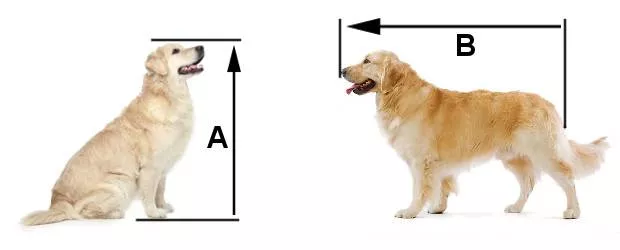
First of all, ask your Golden into a sitting position and referring to the picture, take measurement A. Add 4 inches and this is the height of the crate you want to purchase so your Golden can comfortably sit or stand inside without hitting their head on the ceiling.
Secondly, have your dog stand on all fours and referring to the picture, take measurement B, from the base of their tail to the tip of their nose.
Again, add 4 inches and this is the perfect length of the crate for your Golden to be able to lay down comfortably without being cramped.
So to summarise, your Golden needs a crate of height A plus 4 inches, and of length B plus 4 inches.
The width of the crate will always be in proportion to the previous 2 measurements so isn’t something you need to consider.
So now you will be able to get exactly the right size crate for your adult Golden Retriever. But how about buying a crate for a puppy?
What Size Crate Does A Puppy Need?
As previously discussed, I recommend you purchase a crate for an adult Golden and use a divider to make it suit your puppy, thereby doing away with the need to upgrade to increasingly bigger crates 3 or 4 times during their first 18 months.
I recommend buying a 42″ crate and a divider.
But if you do wish to have crates just right for your puppy without the use of a divider, please take measurements as detailed in the previous section to guide you in your buying decision. And be prepared to upgrade and replace every 4 or so months as they grow.
Now You Know What Size Crate You Need, Which Style Should You Choose?
The sheer number of different styles of dog crates on the market is quite startling. There are crates made of wire, plastic, wood, cloth, and many more besides.
As explained on www.ScoutKnows.com, each type comes with its own advantages and disadvantages, meaning not all types are a perfect fit for all dogs or all owners.
It will be useful for you to know the benefits and drawbacks of each type of crate so you are fully armed to make the correct buying decision, so I’ll briefly discuss these now.
How To Choose The Right Dog Crate?
A Comparison Of Wire, Plastic, Soft-sided And Wooden / Stylish Dog Crates
The style and type of crate you choose for your Golden Retriever will depend on how you intend to use it, whether or not you are looking for a more stylish option to suit your home decor, how destructive your Golden is and their particular preference for being closed in or having some visibility.
With all this in mind I am going to discuss the pros and cons of the 4 following types of dog crates:
- Wire crates
- Wooden / custom-made stylish dog crates
- Plastic crates
- Soft walled / cloth sided crates
Top 5 Best Size Dog Crates: Reviews
1. The Classic Wire Dog Crate
The classic wire dog crate is the most popular and most purchased of the many types of dog crate available.
There is still some variety of styles available within this one type: Some have a single door, some have two or three. Most have a removable plastic tray at the base…but not all. Some are folding for easy storage, others aren’t.
But with these choices aside, what are the pros and cons of a wire crate:
The Advantages Of A Wire Dog Crate
- Very strong, durable and long-lasting
- Very easy to keep clean
- Most have a slide out tray as a base that makes cleaning after accidents very easy (make sure to look for this feature when buying!)
- Folding ones are available for easy storage or moving the crate
- They allow the maximum flow of air compared to other styles, making them most suitable to hotter climates.
- They allow maximum visibility of the surroundings to the dog inside. This can be important for some dogs. while for others that prefer a ‘boxed in’ feeling you can simply cover it. This gives you the ability to test both scenarios out which you can’t with other types.
- Dividers are readily available for most models so you can buy a large one and re-size it for a puppy instead of replacing it as they grow.
Disadvantages Of A Wire Dog Crate
- If you live in a colder climate, they are the type that offers the least shelter. Though you can of course cover them if necessary.
- If you plan on regularly moving your dog’s crate, they are usually quite heavy.
- They are one of the easiest types to escape from if your dog is a budding Houdini!
- They are noisy if placed on solid surfaces and you have a fidgety dog.
Related Article: Buying tips, advice and our pick of 5 best wire dog crates on the market
2. Wooden / Stylish Dog Crates
There’s no denying the addition of a regular wire dog crate isn’t the most stylish thing to adorn a well-kept, stylish and thoughtfully decorated home. Personally, I don’t think they look that bad, but there are certainly more stylish options available.
You can find on the market today dog crates made of different kinds of wood, bamboo, rattan and more besides. But what are the pros and cons of such crates?
The Advantages Of A Wooden / Stylish Dog Crate
- The looks! Some of them are quite stylish and desirable, especially when compared to a wire or plastic crate. You can pick one that slips seamlessly into the overall look and theme of your home.
- They can serve a dual purpose. Not only can they be the perfect den for your dog, but they can also be used as a surface to place ornamental items on, or perhaps as a table for your house phone.
- They aren’t as easy to escape from when compared to a wire crate.
The Disadvantages Of A Wooden / Stylish Dog Crate
- The most expensive of all crate types, many running into hundreds of pounds or dollars.
- Can be easily and irreparably damaged if your dog has destructive behaviors such as scratching and chewing.
- Not the best crate to use during house training because many are difficult to clean thoroughly and can even absorb the moisture following ‘accidents’, leaving them stained and a little bit smelly.
3. Plastic Dog Crates
This type of dog crate is mostly used for pet travel, many of which can come as ‘airline approved’ for air travel. This is certainly something you should look for, the airline approved certification, if that’s the intended crates used.
Mostly the plastic crate is bought as a secondary crate to use for transportation and outside of the home, though they can be used as every day if desired.
The Advantages Of A Plastic Dog Crate
- Lightweight and easy to move around making them ideal for travel.
- Many are ‘Airline approved’, a prerequisite for air travel (cannot fly without such a crate.)
- More ‘boxed in’ and sheltered making them more suitable for colder climates.
- Harder for escapologist dogs to let themselves out.
- Some are dual purpose where the top half can be removed leaving a suitable plastic tray for use as a dog bed.
The Disadvantages Of A Plastic Dog Crate
- Harder to keep clean and odorless when compared to a wire crate, (though easier than a wooden crate.)
- Cannot be folded flat for storage like a wire crate.
- Much less ventilation than other crates due to predominantly solid walls, so not best suited to warm climates.
- Not the best looking of crates to have in the home, though beauty is in the eye of the beholder.
- Unsuitable for some dogs who like great visibility of their surroundings when crated and there’s no way to provide this as the walls are solid (unlike a wire crate that you can cover / uncover.)
4. Fabric / Soft-Sided Dog Crates
Soft walled / cloth crates are good for people who hate the fact some crates look like a cage. They look a little less intimidating. Other pros (and cons) of this crate type are:
The Advantages Of Soft Walled / Cloth Sided Dog Crates
- The lightest, most portable of all crate styles. Many can be completely collapsed and packed into a convenient carry bag.
- Fantastic to take along with you fishing, on picnics or camping to provide your dog with temporary shelter.
- Easily stored away due to the small size when collapsed.
The Disadvantages Of Soft Walled / Cloth Sided Dog Crates
- The most easily damaged and destroyed by dogs who like to scratch or chew.
- The easiest of all crates to escape from. All it takes is a little determined chewing and scratching.
- The least durable and long-lasting of all crates so will need replacing most regularly (where others, particularly wire crates, can last a life time!)
- In my opinion they are the worst looking of all crate types so you likely won’t want one as a permanent fixture in your home.
So What Is The Best Dog Crate For A Golden Retriever And Why?
A collapsible wire dog crate is the best choice for most people and is the type I most recommend.
For puppy’s going through teething, or chewy adolescents, they’re pretty much indestructible. And for use during house training they’re the most easily cleaned after the inevitable accidents.
They can be folded flat for transportation and they’re extremely durable and long-lasting. They’re quite inexpensive to buy in the first place too.
For these reasons, overall they are the most practical and cost-effective crate and the type I recommend for day-to-day use inside of your home. So in my opinion, a folding wire crate is the best crate for a Golden Retriever.
5. The Best Overall Crate For A Golden Retriever: MidWest iCrate Double Door Crate
This is the most popular model of crate from the most popular brand of crate manufacturer in the US, ‘Midwest Homes for Pets.‘
It’s a hard-wearing, easy-clean crate available in various sizes but the 42″ being perfect for an adult Golden Retriever.
However, it comes complete with a divider ‘free of charge’, so this crate can be bought and resized for a puppy, and by moving the divider, resizing the space available for the crate to grow with your puppy until finally it fits them without the divider as an adult dog.
So it offers incredible value, suiting your Golden during every stage of life and removing the need to buy new crates as a puppy grows.
However…
If you’re going to travel a lot and need a crate for this purpose, plastic ones are far better suited and for air travel are in fact the only solution. If you can, I suggest getting one of each, a wire crate for in the home and a plastic one for travel.
If you camp or go fishing regularly and like to take your dog, then a fabric / soft-sided crate is a ‘nice to have‘ object but hardly essential. If you’re not the outdoor pursuits type, then I just wouldn’t bother with a soft-sided crate.
Finally, once your dog is fully house trained and their chewing stage is a distant memory, you cannot beat the good looks and style of a finished wood furniture style crate to replace a traditional wire one. They just look so much nicer in the home.
But most importantly of all, whichever option you choose, make sure you follow the advice in this article on the size of crate you need. Too small is inhumane, too large and your dog may not learn to see it as their den and many of the benefits associated with a crate will be lost.
A Complete Guide To Crate Training From Totally Goldens
For more information on crate training, please see our articles linked below.
In time, this series will become the ultimate guide to crate training and will contain everything a Golden owner needs to know on the subject.
- The Benefits Of Crate Training A Dog Or Puppy
- Is Crate Training Cruel?
- How To Use A Dog Crate: When Should You Crate Your Dog?
- Crate Training: Times When You SHOULD NOT Crate Your Dog
- What Size Dog Crate Do You Need? Which Type Is Best?
- What Should You Put In A Dog Crate And Where To Put It?
- Crate Training Your Puppy Or Dog: A Step-By-Step Guide
Product images: © Chewy.com
Please be aware this page contains affiliate links and TotallyGoldens receives a small commission if you make any purchases through any such links. This has absolutely no effect on the eventual price that you pay and we are very grateful for your support.
This article was adapted with permission from the following article at LabradorTrianingHQ.com on dog crate sizes



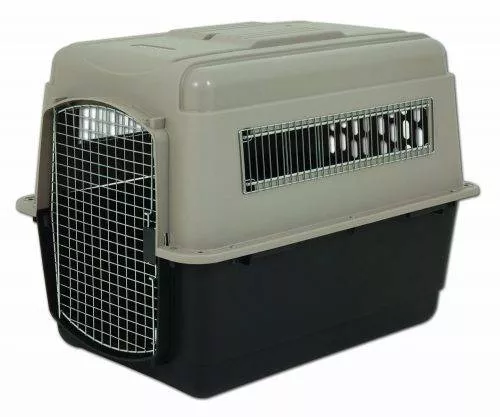
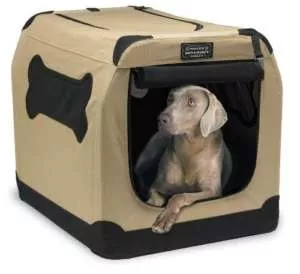
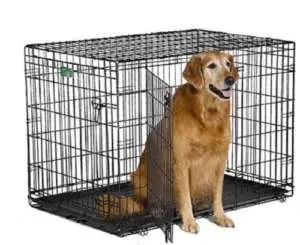



2 Comments
Dev
Which dimension are you referring to with 42 inches, length, width, or height?
Wendy
The dimension listed left to right are Length, Width and Height